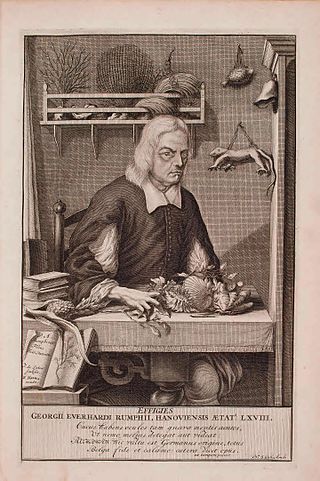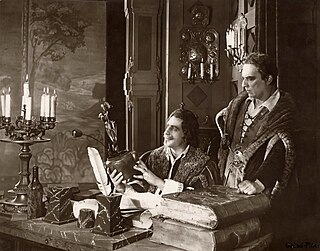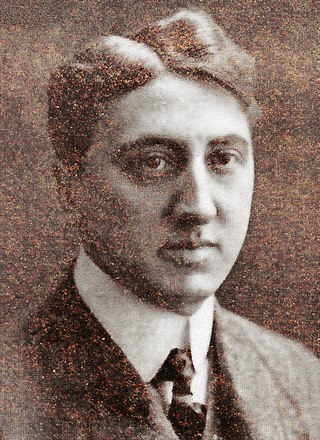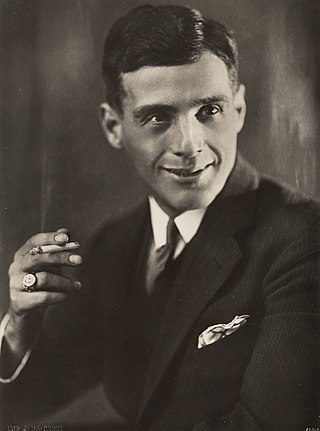
Johan Marius Nicolaas Heesters, known professionally as JohannesHeesters, was a Dutch actor of stage, television and film, as well as a vocalist of numerous recordings and performer on the concert stage with a career dating back to the 1920s. He worked as an actor until his death and is one of the oldest performing entertainers in history, performing shortly before his death at the age of 108. Heesters was almost exclusively active in the German-speaking world from the mid-1930s and became a film star in Nazi Germany, which later led to controversy in his native country. He was able to maintain his popularity in Germany in the decades until his death.

Georg Eberhard Rumphius was a German-born botanist employed by the Dutch East India Company in what is now eastern Indonesia, and is best known for his work Herbarium Amboinense produced in the face of severe personal tragedies, including the death of his wife and a daughter in an earthquake, going blind from glaucoma, loss of his library and manuscripts in major fire, and losing early copies of his book when the ship carrying it was sunk.

St. James' Church is a former collegiate church in Antwerp, Belgium. The church is built on the site of a hostel for pilgrims to Santiago de Compostela. The present building is the work of the Waghemakere family and Rombout Keldermans, in Brabantine Gothic style. The church contains the grave of Peter Paul Rubens in the eastern chapel.

The Black Tulip is a 1921 Dutch silent adventure film directed by Maurits Binger. It is based on the novel The Black Tulip by Alexandre Dumas.
Bleeke Bet is a 1923 Dutch silent film directed by Alex Benno.

The Tars or De Jantjes is a 1934 Dutch comedy film drama directed by Jaap Speyer. The film was a remake of the 1922 film of the same name, which itself was based on a 1920-play by Louis Davids and Margie Morris.
De Vier Mullers is a 1935 Dutch film directed by Rudolf Meinert. A separate version Everything for the Company was produced, also directed by Meinert.
De Familie van mijn Vrouw is a 1935 Dutch comedy film directed by Jaap Speyer.

The Trouble With Money or Komedie om Geld is a 1936 Dutch comedy film directed by Max Ophüls. Producer was Will Tuschinski, son of Abraham Tuschinski. It was released on DVD in 2008.
Kermisgasten is a 1936 Dutch film directed by Jaap Speyer.

De Spooktrein is a 1939 Dutch horror film, directed by Carl Lamac.
De Big van het Regiment is a 1935 Dutch film directed by Max Nosseck.

Jan van Dommelen was a Dutch film actor of the silent era. He appeared in 44 films between 1911 and 1939.
Alex Benno was a Dutch film actor, screenwriter and director of the silent era. He appeared in 15 films between 1913 and 1920.

Hubertus Wijnandus Jozef Marie (Huub) Stapel is a Dutch actor. He is especially known from the films De Lift (1983), Flodder (1986) and Amsterdamned (1988) by Dick Maas. He also appeared in the Golden Earring video When the Lady Smiles.
Jos van Eck is a Dutch former football manager and player. He is team manager of Jong Sparta, the under-21 team of Sparta Rotterdam.

Herman Bouber, born Hermanus Blom was a Dutch actor, screenwriter and playwright. He was married to the actress Aaf Bouber.

The Jordaanlied is a type of levenslied, the Dutch genre of nostalgic sentimental popular music; the Jordaanlied hails from and sings the praises of the Amsterdam neighborhood the Jordaan which, until the 1960s, was an impoverished working-class area. The genre first came to the fore in the late 19th century and reached extraordinary popularity in the 1950s, before becoming old-fashioned quickly when rock and roll came along. It continues to be sung in the now-yuppified Jordaan, as a local favorite and a tourist attraction in a profoundly changed neighborhood; already a nostalgic genre when it was first made popular, the situations it describes and the emotions it evokes are no longer directly accessible even by the older generations, a transformation due in part to the Jordaanlied itself.

Louis Davids was a Dutch actor, singer, comedian and revue artist. He is widely considered one of the biggest names in Dutch performing arts.

Onze Kunst van Heden was an exhibition held in the winter of 1939 through 1940 at the Rijksmuseum in Amsterdam. Due to the threat of invasion in the years leading up to World War II, the Netherlands' government stored many items from the Rijksmuseum's permanent collection. The resulting empty gallery space was utilized by contemporary Dutch artists to exhibit and sell their art. It was organized by the director of the Rijksmuseum Frederik Schmidt Degener. The show was open to all artists, with each artist allowed to enter four pieces. 902 artists exhibited 3,200 works of art in 74 rooms and cabinets of the Rijksmuseum.
„De kunstenaar kan in tijden van maatschappelijke benauwenis weinig positiefs doen om rampen af te wenden, maar wel kan hij door mede te helpen nationale uitingen op het eigenaardigst naar voren te brengen het gemeenschapsbesef versterken. Wanneer de belangstelling van het publiek uitgaat naar deze manifestatie, die in zulk een omvang in Holland nog niet gezien is, dan zal menige kunstenaar zich op zijn beurt gesterkt voelen".
"The artist can do little positive in times of social distress to avert disasters, but he can, by helping to bring out national expressions in the most idiosyncratic way, strengthen the sense of community. When the public is interested in this event, which has not yet been seen to such an extent in Holland, many artists will feel strengthened in turn."
This page is based on this
Wikipedia article Text is available under the
CC BY-SA 4.0 license; additional terms may apply.
Images, videos and audio are available under their respective licenses.












